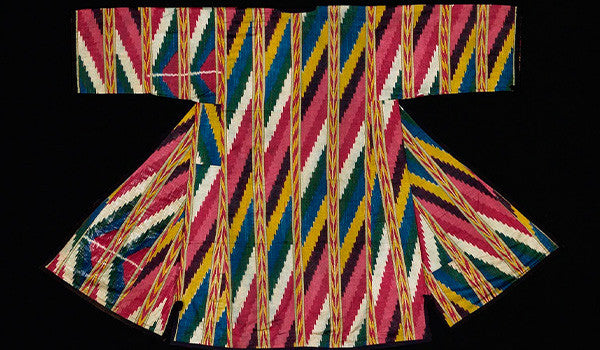
IKATS IN HOUSTON
The word ‘ikat’ as we know it is widely used to refer to the kinds of cloths that often display bold, primary colours and graphic designs. What many may not know however, is that the term itself refers to the process by which these designs are made, originating from the Malay word ‘mengikat’ meaning to tie or to bind. Referring to this type of tie-dyeing method, this hugely detailed process is what gives this textile its recognisably vibrant palette the world over – and the range of ikat on show now at the Museum of Fine Arts in Houston, is no exception.
Organised by the George Washington University Museum and the Textiles Museum, this exhibition Colours of the Oasis: Central Asian Ikats showcases nearly 50 ikat robes and panels from the renowned Murad Megalli Collection of the Textile Museum in Washington D.C. These bold garments were mainstays of cosmopolitan oasis culture in the 19th century, worn by inhabitants of different classes and religions throughout crowded marketplaces, private homes, centres of worship, and ceremonial places. The ikat textiles on display – including robes for men and women, dresses, trousers, and hangings – feature eye-catching designs in dazzling colours. Made in the weaving centres of Uzbekistan, Bukhara, Samarkand and the Fergana Valley, these garments are a testimony to central Asia’s historic reputation as the world’s largest manufacturer of ikat. The technique is notoriously difficult, using various sections of yarn treated to resist the dye bath, demanding meticulous planning and mathematical savvy in order to execute such complicated compositions.
 Alongside the ikats themselves are a selection of historical photographs and other materials to give further insight into the craft’s tradition. And for any visitors with extra time on their hands, special installations of ikat textiles from India, Japan, and Central Asia are also on view in the Museum’s permanent galleries in the Law Building. Running until the month of July, this show offers a worldwide perspective on Central Asia’s prowess in the tradition of ikat. For more information visit: www.mfah.org/exhibitions/colors-of-the-oasis-central-asian-ikats
Alongside the ikats themselves are a selection of historical photographs and other materials to give further insight into the craft’s tradition. And for any visitors with extra time on their hands, special installations of ikat textiles from India, Japan, and Central Asia are also on view in the Museum’s permanent galleries in the Law Building. Running until the month of July, this show offers a worldwide perspective on Central Asia’s prowess in the tradition of ikat. For more information visit: www.mfah.org/exhibitions/colors-of-the-oasis-central-asian-ikats

